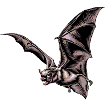Museum, University of Nebraska State

University of Nebraska State Museum: Mammalogy Papers
Document Type
Article
Date of this Version
2-14-1981
Citation
Journal of Mammalogy (1981) 62(1): 166-173.
Journal website: http://www.mammalsociety.org/pubjom/index.html
Abstract
In a morphometric study of molossid bats (Freeman, in press), I found that the first principal component (PC) reflected overall size. The second PC was concerned with a suite of jaw and skull measurements that separated molossids with thicker jaws, fewer but larger teeth, and welldeveloped cranial crests (i.e., bats with robust skulls) from those with thinner jaws, more but smaller teeth, and less developed cranial crests. Subsequently, I found (Freeman, 1979) that molossids with robust skulls ate hard-shelled insects such as beetles. and that molossids with gracile skulls ate soft-bodied insects such as moths. Given these conclusions I was curious as to the generality of this observation in other species of microchiropterans. This paper reports my findings on the correspondence of morphology and food habits of 41 species of insectivorous bats.


Comments
Copyright © 1981, American Society of Mammalogists. Used by permission.